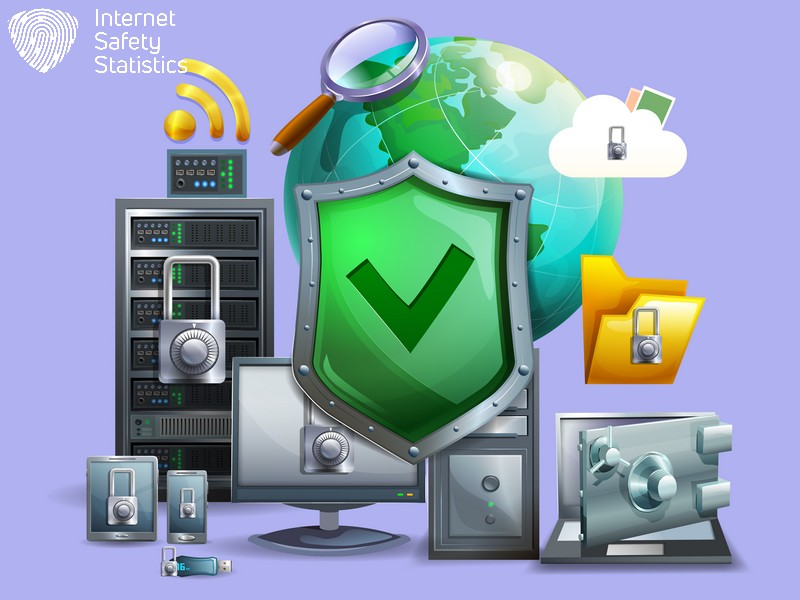
Every day, our data risks falling into the wrong hands. Shockingly, a large number of internet users remain in the dark about their own data protection rights. This lack of knowledge exposes them to data breaches and misuse risks. This guide empowers you to take control of your online privacy. This article will guide you through simple yet effective methods to protect sensitive information online, ensuring you can browse freely. Let’s dive in and secure your digital life. With these best practices, you can confidently navigate the internet, ensuring your data remains secure.
Understanding Data Protection
Data protection protects sensitive information from unauthorised access, use, disclosure, alteration, and destruction. It is vital for ensuring privacy and security in an increasingly digital world. Understanding data protection is crucial for internet users to keep their personal and sensitive data safe from cyber threats.
Definition
Data protection involves the methods and strategies to keep important information safe from unauthorised access, corruption, or theft. It’s a critical practice that ensures sensitive data stays out of the wrong hands while maintaining its availability for legitimate use. This process is key to securing personal details, financial records, and other vital information that could cause harm if exposed.
Every user has a role in defending digital privacy and contributing to broader cybersecurity efforts. Encrypting files ensures they’re unreadable to intruders, even if they manage to break through your initial defences.
Following guidelines such as GDPR helps users understand how companies must handle their data securely and give them rights over their information. Implementing strong measures like these protects against identity theft and builds trust between service providers and consumers in our increasingly connected world.
Importance
After understanding what data protection entails, it’s crucial to grasp the significance of implementing robust data security measures. For internet users, including parents and office workers, this holds particular relevance given the increasing frequency of cyber threats.
Data protection is essential for safeguarding sensitive information from unauthorised access, corruption, or loss. With 67% of UK internet users unaware of their country’s privacy and data protection rules, it becomes even more critical to prioritise comprehensive measures to protect personal and professional data.
Implementing a Principle of Least Privilege (PoLP) when controlling access to sensitive information ensures that only authorised individuals can view or modify such data.
Best Practices for Internet Users
Identify and classify sensitive data, create a data usage policy, implement access controls, use data encryption, back up your data, and perform vulnerability assessments and cybersecurity penetration tests. These best practices will help internet users protect their personal information and prevent unauthorised access to sensitive data.
Identify and Classify Sensitive Data
Understanding and identifying what sensitive data is and then classifying it correctly is crucial to ensure data protection. Here are some key steps to accomplish this:
- Take inventory of all the data you collect, store or process.
- Classify each type of data according to its sensitivity level and regulatory requirements.
- Label or tag sensitive data with appropriate security measures based on its classification.
- Implement automated tools for identifying and classifying sensitive data across your network.
- Regularly review and update the classification of data as necessary to ensure accuracy.
Create a Data Usage Policy
Creating a data usage policy is crucial for safeguarding sensitive information within an organisation. This policy outlines guidelines for properly handling, storing, and sharing data to ensure its security and privacy.
By clearly defining acceptable use, access controls, and encryption requirements, a data usage policy helps protect against unauthorised data access or leaks. It also educates employees about their responsibilities in protecting sensitive information, promoting a culture of data security awareness throughout the organisation.
A comprehensive data usage policy mitigates the risk of insider threats and ensures compliance with data protection regulations such as GDPR. Effective communication and regular training on the policy are essential to fostering a proactive approach to ensuring data security within the workplace.
Implement Access Controls
After creating a data usage policy, it is crucial to implement access controls to ensure the security of sensitive data. Access controls restrict unauthorised users from accessing sensitive information, helping to maintain data privacy and integrity. Here are some best practices for implementing access controls:
- Use role-based access control (RBAC) to assign permissions based on job responsibilities and requirements.
- Utilise multi-factor authentication (MFA) to add an extra layer of security by requiring additional verification steps.
- Regularly review and update user access rights to align with changing roles and responsibilities.
- Implement strong password policies, including regular password changes and complexity requirements.
- Leverage network segmentation to isolate sensitive data and restrict access to authorised personnel.
- Monitor and log all access attempts to detect any unauthorised or suspicious activities.
Use Data Encryption

Data encryption is a crucial step in safeguarding sensitive information from unauthorised access. Encoding data into an unreadable format ensures that even if hackers intercept it, they cannot decipher it without the correct decryption key.
This added security layer helps protect personal and business information from cyber threats. Furthermore, encryption is essential for ensuring GDPR compliance and maintaining online privacy best practices.
Implementing data encryption can significantly enhance your online safety and contribute to the overall protection of sensitive information. It is a fundamental aspect of cybersecurity best practices and should be prioritised by individuals and businesses to mitigate potential risks associated with data breaches.
Back-Up Your Data
It’s crucial to back up your data regularly to protect it from loss or damage. Here are some best practices for backing up your data:
- Utilise cloud storage services or external hard drives to regularly back up important files and documents.
- Set up automatic backup schedules to ensure your data is consistently saved without manual intervention.
- Keep multiple copies of your backups in different locations to safeguard against physical damage, theft, or natural disasters.
- Test your backups periodically to verify their integrity and ensure you can recover your data if needed.
- Consider employing backup encryption methods to secure sensitive information stored in your backups.
Perform Vulnerability Assessments and Cybersecurity Penetration Tests
You can hire ethical hackers to identify vulnerabilities in your system. Their job is to test the system and thoroughly assess your network, applications and infrastructure. Identifying vulnerabilities will make it harder for cyberattackers to exploit them and gain unauthorised access to your data.
- Identify and prioritise the assets that need protection, including sensitive data, customer information, and critical systems.
- Conduct thorough network, applications, and infrastructure assessments to identify potential vulnerabilities.
- Automated tools and manual testing techniques simulate real-world attacks and uncover potential security gaps.
- Analyse the results of the assessments to determine the severity of vulnerabilities and prioritise them based on their potential impact.
- Develop a comprehensive plan to address identified vulnerabilities, including patching systems, updating software, and implementing additional security controls.
- Regularly re-assess your systems to ensure new vulnerabilities are promptly identified and mitigated.
Data Protection Technologies and Practices
Data protection technologies and practices are essential for safeguarding sensitive information as technology evolves. From data discovery to access controls and encryption, these tools and strategies help ensure the security of your data.
Data Discovery
Identifying sensitive data is a crucial step in safeguarding personal information. By discovering where sensitive data resides within your digital environment, you can effectively implement security measures to protect it from unauthorised access or breaches.
Understanding what data requires protection allows establishing appropriate policies and controls to maintain privacy and integrity. Incorporating regular data discovery processes into your online activities ensures you know potential vulnerabilities and can proactively mitigate risks.
Implementing data discovery practices empowers individuals and organisations to maintain control over their information, enhancing their ability to comply with privacy regulations and protect against cyber threats.
Data Mapping
Data mapping involves identifying and documenting where sensitive data is stored, how it flows through an organisation, and who has access to it. This practice helps understand the data landscape, enabling organisations to implement security measures and comply with privacy regulations effectively.
By conducting data mapping exercises, businesses can gain insights into potential vulnerabilities and ensure appropriate controls are in place to protect sensitive information from unauthorised access or breaches.
Understanding your organisation’s data flow is crucial for effective data protection. Data mapping enables you to identify weak points in your data security infrastructure and take the necessary steps to fortify them.
Data Loss Prevention
Data loss prevention measures are essential to safeguard sensitive information from unauthorised access or accidental deletion. By using technologies such as data discovery, organisations can identify and classify sensitive data, enabling them to monitor its usage effectively.
Access controls prevent data loss by restricting access to authorised personnel only. Regular vulnerability assessments and cybersecurity penetration tests help identify potential weaknesses and fortify the system against data breaches.
Data encryption adds an extra layer of security, ensuring that even if data is compromised, it remains unintelligible to unauthorised individuals. Additionally, backing up data regularly provides a safety net in case of accidental deletion or system malfunctions.
Storage with Built-in Data Protection

Data protection is enhanced through storage solutions with built-in data security measures. These technologies help safeguard sensitive information from unauthorised access, corruption, and loss.
Implementing storage with built-in data protection ensures that critical data remains secure and readily available when needed. By encrypting data at rest and in transit, these systems provide an added layer of defence against potential breaches or cyber-attacks.
Access controls further restrict unauthorised access to sensitive information, promoting the privacy and integrity of stored data. In addition to encryption and access controls, implementing storage with built-in data protection assists in complying with data privacy regulations while minimising non-compliance risk.
Access Controls
When discussing data protection best practices, implementing access controls is a critical step in ensuring the security of sensitive information. Access controls involve managing who can access specific data and what actions they can perform with it.
By using this principle, organisations can limit potential risks by only granting employees access to the data necessary for their roles, following the Principle of Least Privilege (PoLP). This helps prevent unauthorised access and misuse of sensitive information.
Access controls also play a vital role in safeguarding personal information for internet users. By setting up strong passwords and multi-factor authentication, individuals can protect their online accounts from unauthorised access.
Encryption
Data encryption is vital for protecting sensitive data by converting it into an unreadable format requiring a specific key or password. This process helps safeguard information from unauthorised access, ensuring that even if the data is intercepted, it remains unintelligible to hackers and cybercriminals.
Implementing encryption is crucial in maintaining data privacy and compliance with regulations, contributing significantly to overall data protection efforts. Implementing encryption measures strengthens internet security for personal and professional use, helping users protect their sensitive information while fostering trust in digital interactions.
Critical Best Practices for Ensuring Data Privacy
Inventory your data, minimise data collection, securely destroy old data, conduct regular risk assessments, train employees on data protection and implement a risk-based approach to security. Keep reading to learn more about these critical best practices for ensuring data privacy!
Inventory Your Data
Creating an inventory of your data helps organise and classify it. This process helps you easily track and identify affected data during a cyber attack. Here are the most effective ways to create your data inventory.
- Classify the data: Categorise your information into different sensitivity levels to identify what needs the most protection.
- Determine data location: Keep track of where your data is stored to ensure it’s secure and easily accessible when needed.
- Identify potential risks: Recognise possible threats to your data’s security by regularly assessing vulnerabilities and taking necessary precautions.
- Create a backup plan: Establish a backup system to safeguard against potential loss or corruption of important information.
- Limit access: Use access controls to grant permission only to authorised individuals and prevent unauthorised access.
- Implement encryption: Ensure that sensitive data is encrypted to add an extra layer of protection from potential breaches or cyberattacks.
- Conduct regular reviews: Regularly review and update your data inventory to adapt to changing circumstances and new security challenges.
Minimise Data Collection
Minimising data collection is crucial for protecting sensitive information. It involves only collecting the necessary data for specific purposes, reducing the risk of unauthorized access and potential breaches. By minimising data collection, individuals and organisations can lower the amount of personal information stored, enhancing overall data security and privacy.
This practice aligns with the principle of least privilege (PoLP) by limiting the exposure of sensitive data. Additionally, it helps to ensure compliance with data protection regulations such as GDPR by only retaining essential information.
Securely Destroy Old Data
To ensure data privacy and security, securely destroying old data is crucial. By permanently deleting outdated files and information from devices, you can prevent unauthorised access and reduce the risk of data breaches.
Implementing a regular process for securely erasing old data helps to maintain compliance with data protection regulations and safeguards sensitive information from falling into the wrong hands.
With 67% of internet users in the UK unaware of their country’s privacy rules, individuals need to take proactive steps to protect their personal information. Securely destroying old data also aligns with best practices for end-users in safeguarding personal integrity and promoting trust in digital interactions.
Conduct Regular Risk Assessments

After securely destroying old data, it is crucial to conduct regular risk assessments to ensure the ongoing protection of sensitive information. These assessments are essential for identifying and evaluating potential risks to data security. Here are the critical steps for conducting regular risk assessments:
- Begin by inventorying your organisation’s data, including personal and sensitive information.
- Identify potential threats and vulnerabilities that could compromise the security of this data.
- Assess the likelihood and impact of these threats, prioritising them based on their severity.
- Develop mitigation strategies to address these risks, implementing controls and procedures to reduce their likelihood of occurrence.
- Regularly review and update your risk assessment process to adapt to evolving cybersecurity threats and changes in your organisation’s data environment.
- Train employees on recognising and reporting potential security risks as part of their ongoing responsibilities.
- Continuously monitor and evaluate the effectiveness of your risk management strategies, making adjustments as needed to address new or emerging threats.
Train Employees on Data Protection
- Educate employees on the importance of data protection and their role in maintaining it.
- Teach them how to identify sensitive data and handle it securely.
- Guide on creating strong passwords and recognising phishing attempts.
- Instruct employees on properly using encryption and access controls to safeguard data.
- Conduct regular training sessions about emerging cybersecurity threats and best practices for mitigating them.
- Ensure employees understand the legal requirements and compliance standards related to data protection.
Implement a Risk-Based Approach to Security
Assessing potential risks to your data and prioritising security measures accordingly is crucial. Embrace a risk-based approach by evaluating the likelihood and impact of different threats to your information. Tailoring security efforts towards higher risks ensures efficient resource allocation while maximising protection. Identify vulnerabilities within your system proactively, addressing them before they become significant breaches.
Understanding the specific risks to data privacy is vital for creating effective protection strategies. By acknowledging potential threats, organisations can apply targeted controls and preventative measures where they are most needed, enhancing overall security posture. Prioritising areas of highest risk allows for a more focused and strategic approach to safeguarding sensitive information.
Protecting your data is crucial in the digital age. You can minimise the risk of unauthorised access by following best practices, such as identifying sensitive data and implementing access controls. Regularly backing up your data and conducting vulnerability assessments will strengthen your defences. Embracing a proactive approach to data protection empowers you to navigate the online landscape confidently.
FAQs
1. What are some data security best practices for internet users?
Internet users can follow cyber security best practices by creating strong passwords, regularly updating software, and being cautious of suspicious links to protect their personal information.
2. How important is the Principle of Least Privilege (PoLP) in data protection?
The Principle of Least Privilege is crucial as it limits access rights for users to the bare minimum needed to complete their tasks, reducing the risk of data breaches.
3. Why should businesses implement data protection policies?
Businesses must implement robust data protection policies to safeguard customer information, comply with privacy regulations, and maintain trust by keeping data secure against cyber threats.
4. Can healthcare organisations benefit from specific information and data protection measures?
Yes, healthcare organisations must adopt stringent information and data protection measures due to handling sensitive patient information; they need tailored solutions that ensure compliance while securing personal health details.
